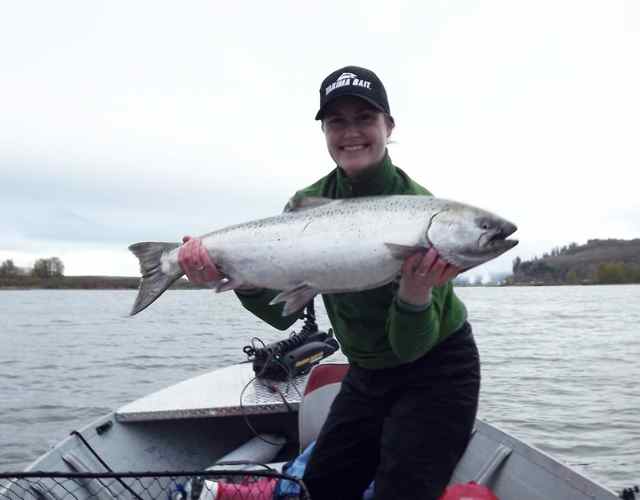forum
library
tutorial
contact

Spring Chinook Losses Above
Bonneville Remain a Mystery
by Bill Rudolph
NW Fishletter, June 5, 2014
|
the film forum library tutorial contact |

|
Spring Chinook Losses Above
by Bill Rudolph
|
 Research conducted last year has found that nearly 20 percent of radio-tagged adult spring Chinook went missing in the lower Columbia River between Bonneville and McNary dams. The BiOp-mandated research is trying to help figure out why adult survival of some ESA-listed Snake River salmon and steelhead stocks has dropped below performance standards mandated in the latest biological opinion.
Research conducted last year has found that nearly 20 percent of radio-tagged adult spring Chinook went missing in the lower Columbia River between Bonneville and McNary dams. The BiOp-mandated research is trying to help figure out why adult survival of some ESA-listed Snake River salmon and steelhead stocks has dropped below performance standards mandated in the latest biological opinion.
After tagging 900 spring/summer Chinook and 400 sockeye with both radio tags and PIT tags, preliminary results show that 69 percent of the adult Chinook, 83 percent of the jacks, and 83 percent of the sockeye released below Bonneville Dam passed McNary Dam. The draft says that most of these fish were ultimately detected in the Snake or upper Columbia.
When tributary turnoffs were factored in, about 8 percent in the case of Chinook, and a self-reported harvest rate of about 4.5 percent, nearly 18 percent of the tagged Chinook were still unaccounted for. For sockeye, about 14 percent were ultimately unaccounted, along with 5 percent of the jack Chinook.
The May 1 draft report, sponsored by the Corps of Engineers, said conversion rates were lowest between Bonneville and The Dalles dams, where most fisheries were conducted. About 44 percent of unaccounted for adult Chinook salmon went missing in this 57-mile reach, along with 59 percent of unaccounted for sockeye and 55 percent of jack Chinook.
"Unreported harvest and mortality associated with gillnet dropout and catch and release recreational fisheries are presumed to contribute to the unaccounted for rate in this reach (and others)," said the draft report, which noted that transmitter loss could also be a contributing factor, though a new PIT array at the Dalles Dam and another at the mouth of the Deschutes River "substantially reduces the likelihood that unaccounted for fish passed through The Dalles Dam undetected."
The researchers said some additional fish could have entered tributaries undetected, "though we think the incidence of this was low given redundancy between radiotelemetry, PIT detection sites, and recapture data from tributary hatcheries."
Matt Keefer of the University of Idaho, and one of the lead researchers, said the radio-tag tracking is being undertaken to satisfy a BiOp requirement and give policymakers a better sense, geographically, where the fish are falling out of the migration--which is a lot harder to determine with PIT tags alone.
The draft report also found lower survival for late-migrating sockeye and adult Chinook, and that hatchery Chinook had a 7 percent lower conversion rate than wild Chinook from Bonneville to McNary.
Also, fish that fell back downstream after ascending fish ladders were considerably less likely to survive through the study reaches.
Keefer noted that the 2013 tracking got off to a slow start over an issue with the radio tags. No Chinook were tagged in April, though 29,000 adults and 2,000 jacks passed through the hydro system that month.
It's likely that some earlier running stocks were under-sampled, like those from the Clearwater, Salmon, Icicle, Wind, and John Day rivers, so conversion rates and tributary turnoff estimates could differ from the runs at large. The lack of April tagging could also have reduced any potential effects from sea lion predation. Keefer said summer steelhead will be part of the study this year.
The researchers faced another headache when other scientists conducting PIT tag work with the Comparative Survival Study would not allow their tagged fish to be used in the radio-tagging program over concern that their smolt-to-adult survival results could be biased.
"Unfortunately," said the draft report, "thousands of jack and adult Chinook salmon and steelhead have PIT tags and represent substantial portions of the runs passing Bonneville Dam. The PIT-tagged Chinook salmon and steelhead disproportionately originate from interior populations in the Snake, mid- and upper-Columbia River basins. Selection against these known-origin groups for radio-tagging--many of which are from the ESA-listed groups that are the motivation for the conversion rate study--was an unfortunate methodological constraint."
The unexplained losses have been studied off and on for years, but the dip in conversion rates for Snake River stocks in recent years has troubled agencies. A 2005 report commissioned by the Corps of Engineers that looked at fish returns between 1996 and 2002 found that 12-17 percent of each run "had unknown fates within the hydro system."
The BiOp performance standard for Snake spring/summer Chinook calls for a 91-percent conversion rate between Bonneville and Lower Granite dams, but PIT tag analyses from 2008 to 2012 showed that only 82 percent made it all the way. Snake River steelhead had a similar conversion rate in recent years, well below the BiOp's performance standard of 90.1 percent.
Meanwhile, upper Columbia spring adult Chinook and steelhead seem to be meeting or surpassing their Bonn-McNary performance standards.
A recent review of fish returns and improvements to hydro operations said the drop in adult survival was a concern that warranted further investigation, and speculated that the added mortality could come from a variety of sources, including natural causes, impaired passage from high flow or spill, direct or indirect effects of harvest, increased straying and delayed effects of marine mammal attacks.
By determining that nearly half of the unaccounted for spring/summer Chinook losses likely occurred between Bonneville and The Dalles dams, this new study is already beginning to home in on some answers.
learn more on topics covered in the film
see the video
read the script
learn the songs
discussion forum
